Paper Menu >>
Journal Menu >>
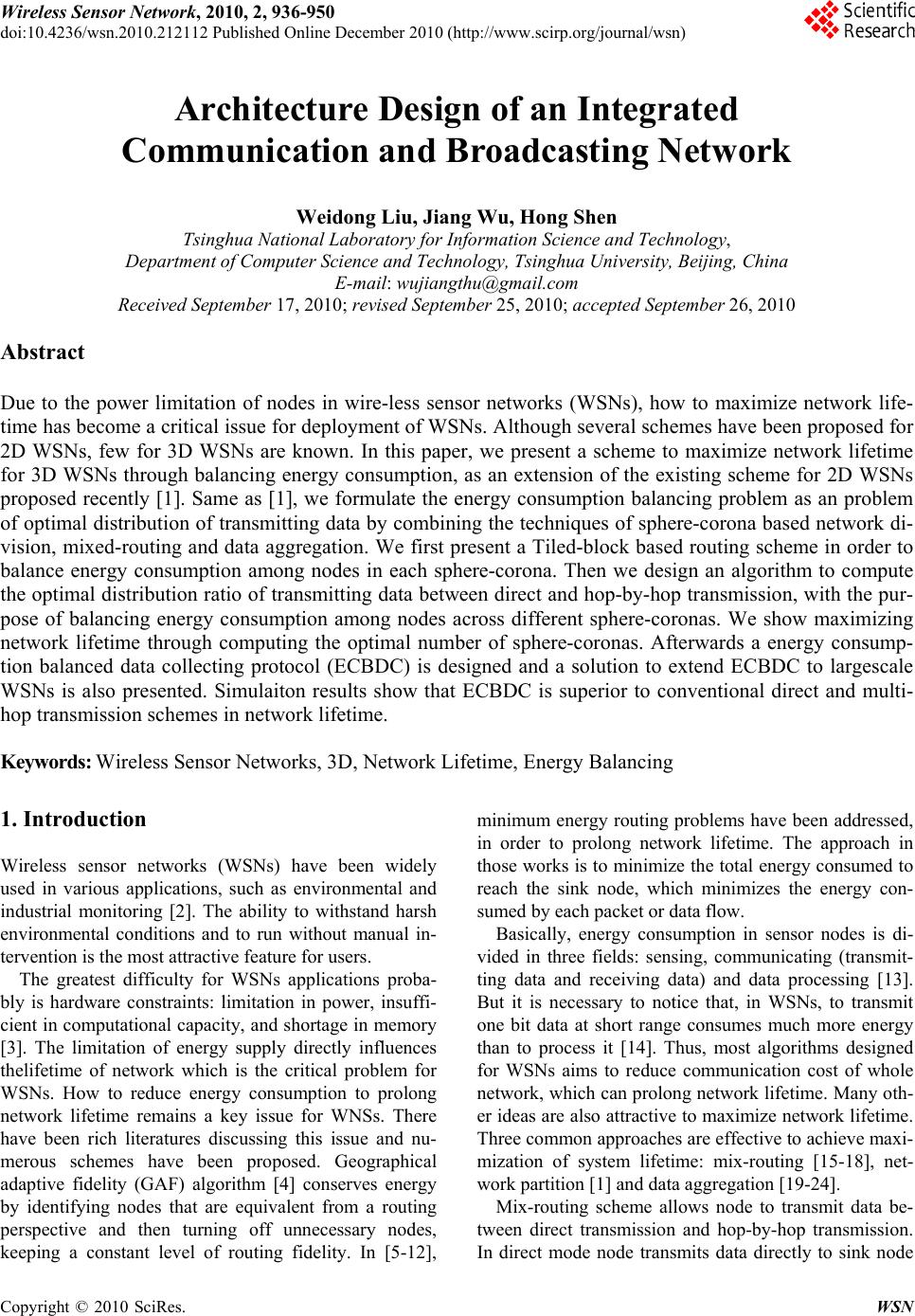 Wireless Sensor Network, 2010, 2, 936-950 doi:10.4236/wsn.2010.212112 Published Online December 2010 (http://www.scirp.org/journal/wsn) Copyright © 2010 SciRes. WSN Architecture Design of an Integrated Communication and Broadcasting Network Weidong Liu, Jiang Wu, Hong Shen Tsinghua National Laboratory for Information Scien ce and Technology, Department of Com put er Science and Technology, Tsi n g hu a Universi t y, Beijing, Chin a E-mail: wujiangthu@gmail.com Received September 17, 2010; revised September 25, 2010; accepted September 26, 2010 Abstract Due to the power limitation of nodes in wire-less sensor networks (WSNs), how to maximize network life- time has become a critical issue for deployment of WSNs. Although several schemes have been proposed for 2D WSNs, few for 3D WSNs are known. In this paper, we present a scheme to maximize network lifetime for 3D WSNs through balancing energy consumption, as an extension of the existing scheme for 2D WSNs proposed recently [1]. Same as [1], we formulate the energy consumption balancing problem as an problem of optimal distribution of transmitting data by combining the techniques of sphere-corona based network di- vision, mixed-routing and data aggregation. We first present a Tiled-block based routing scheme in order to balance energy consumption among nodes in each sphere-corona. Then we design an algorithm to compute the optimal distribution ratio of transmitting data between direct and hop-by-hop transmission, with the pur- pose of balancing energy consumption among nodes across different sphere-coronas. We show maximizing network lifetime through computing the optimal number of sphere-coronas. Afterwards a energy consump- tion balanced data collecting protocol (ECBDC) is designed and a solution to extend ECBDC to largescale WSNs is also presented. Simulaiton results show that ECBDC is superior to conventional direct and multi- hop transmission schemes in network lifetime. Keywords: Wireless Sensor Networks, 3D, Network Lifetime, Energy Balancing 1. Introduction Wireless sensor networks (WSNs) have been widely used in various applications, such as environmental and industrial monitoring [2]. The ability to withstand harsh environmental conditions and to run without manual in- tervention is the most attractive feature for users. The greatest difficulty for WSNs applications proba- bly is hardware constraints: limitation in power, insuffi- cient in computational capacity, and shortage in memory [3]. The limitation of energy supply directly influences thelifetime of network which is the critical problem for WSNs. How to reduce energy consumption to prolong network lifetime remains a key issue for WNSs. There have been rich literatures discussing this issue and nu- merous schemes have been proposed. Geographical adaptive fidelity (GAF) algorithm [4] conserves energy by identifying nodes that are equivalent from a routing perspective and then turning off unnecessary nodes, keeping a constant level of routing fidelity. In [5-12], minimum energy routing problems have been addressed, in order to prolong network lifetime. The approach in those works is to minimize the total energy consumed to reach the sink node, which minimizes the energy con- sumed by each packet or data flow. Basically, energy consumption in sensor nodes is di- vided in three fields: sensing, communicating (transmit- ting data and receiving data) and data processing [13]. But it is necessary to notice that, in WSNs, to transmit one bit data at short range consumes much more energy than to process it [14]. Thus, most algorithms designed for WSNs aims to reduce communication cost of whole network, which can prolong network lifetime. Many oth- er ideas are also attractive to maximize network lifetime. Three common approaches are effective to achieve maxi- mization of system lifetime: mix-routing [15-18], net- work partition [1] and data aggregation [19-24]. Mix-routing scheme allows node to transmit data be- tween direct transmission and hop-by-hop transmission. In direct mode node transmits data directly to sink node  W. D. LIU ET AL. Copyright © 2010 SciRes. WSN 937 while transmitting data to next hop node in hop-by-hop mode. Energy consumption balance may be achieved if node chooses an appropriate data allocation in these two transmission modes, and then maximization of network lifetime could be achieved accordingly. Network partition has great influence on network life- time. A good dividing method may reduce the amount of data transmitted, save energy of sensor nodes, and then prolong the system lifetime. Slice-based partition and corona-based partition are two common methods for network partition. Slice-based partition divide circular network into slices. And Corona-based partition method divides circular network area into coronas centred with sink node with different radius. Data aggregation is a useful technique to eliminate redundant data of network. Nodes in small area are close to each other and may generate redundant sensing data in WSNs like temperature monitoring WSNs. In data ag- gregation a node may pack its input data into a different size outputted, reduce unnecessary data transmission and save energy, which extends the lifetime of network. For common situations, WSNs are mainly used in a two dimensional environment. Recently there are emer- ging applications deploying WSNs in a three dimension- al environment, such as marine environment monitoring and safety monitoring for coal mine that have attracted interesting attention. Compared to 2D deployment, due to the sufficient increase in the number of sensor nodes within the coverage of WSNs in a 3D deployment, the limit in power storage and supply remains even more severe for WSNs in 3D applications. In this paper, we present a method to maximize network lifetime by ba- lancing the energy consumption at all nodes for 3D WSNs deployment. The main contributions of this paper can be summarized as follows: • Similar to the zone based routing scheme in [1], we propose a routing scheme called tiled-block routing for 3D environment. Our work is inspired and extends the solution of [1] from 2D to 3D. • Using a method similar to corona-partition, we pro- pose a decomposing method that decomposes a 3D mon- itoring sphere space into sphere-coronas, and then break energy consumption balance down to two levels: intra sphere-corona and inter sphere-corona. • We propose a scheme to achieve intra energy con- sumption balance, through partitioning each sphere co- rona into a set of sphere subcoronas, such that data transmission takes place only between two sphere sub- coronas that have the same relative positions in two neighbouring sphere-coronas. • We propose a scheme to achieve inter energy con- sumption balance, by computing a proper data distribu- tion ratio for each sphere-corona between direct and hop-by-hop transmission. • We show that maximizing network lifetime can be achieved through setting an optimal number of sphere-coronas and that of sphere subcoronas within each corona. This paper is organized as follows: Section 2 presents the system model and the statement of problems. Sec- tions 3 and 4 give the solutions for the intra sphere coro- na energy balance problem and inter sphere-corona energy balance problem. Section 5 solves the maximiz- ing network lifetime problem. Section 6 presents a pro- tocol called ECBDC and Section 7 give the solutions to extend ECBDC to large-scale sensor network. In Section 8, the ECBDC is evaluated through simulation and com- pared to other protocols. And the conclusion of this pa- per is given in Section 9. 2. System Models and Problem Statement 2.1. Network Model We assume that all sensor nodes are distributed in a sphere space S of radius R, in which the node distribu- tion density is ρ. There is only one sink node that is lo- cated at the core of S. All nodes have the same maximum range of transmission Tmax that is larger than R and the same amount of initial energy. Every node knows its geographic location. The data operation is divided into T rounds. In one word, nodes receive data and generate data then transmit it in one round. In the gap of two adjacent rounds, nodes turn off its radio to save the energy. 2.2. Data Aggregation Model We use a function [25] to illustrate the data aggregation model: x mx c (1) where φ(x) is the amount of data output, x is the amount of data received, m is the aggregation propor- tion and c is a const that depends on specific situation: • If m = 0 and c > 0, the amount of data that will be transmitted in one node in one round is small so that it can be put in a single packet. • If m = 1 and c = 0, in this case, the node does not perform any data aggregation. • If 0 < m < 1 and c = 0, the node compresses the data output by a factor of m. 2.3. Energy Model The energy consumption function is given below: k elec amp x x (2) 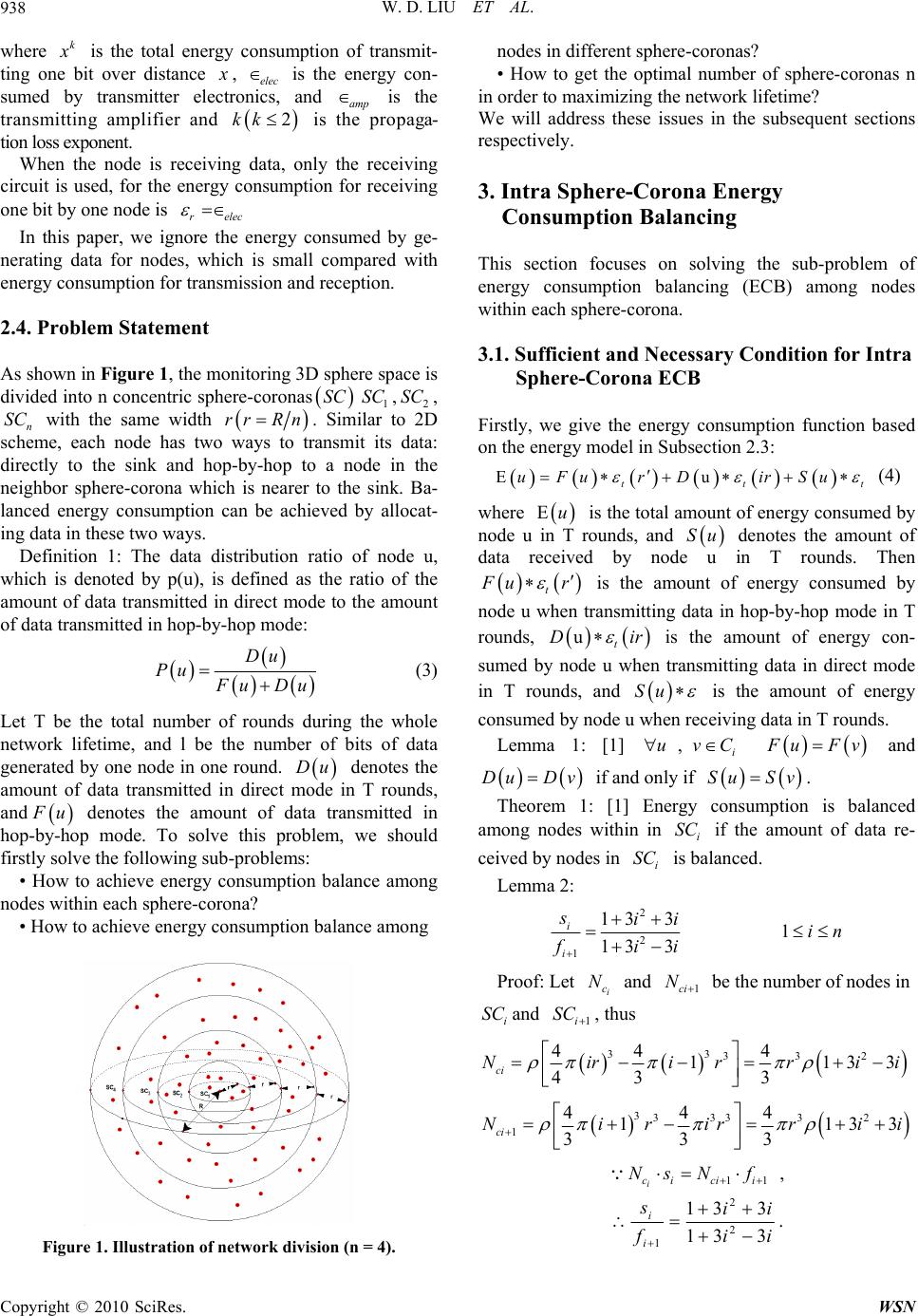 W. D. LIU ET AL. Copyright © 2010 SciRes. WSN 938 where k x is the total energy consumption of transmit- ting one bit over distance x , elec is the energy con- sumed by transmitter electronics, and amp is the transmitting amplifier and 2kk is the propaga- tion loss exponent. When the node is receiving data, only the receiving circuit is used, for the energy consumption for receiving one bit by one node is relec In this paper, we ignore the energy consumed by ge- nerating data for nodes, which is small compared with energy consumption for transmission and reception. 2.4. Problem Statement As shown in Figure 1, the monitoring 3D sphere space is divided into n concentric sphere-coronas SC 1 SC ,2 SC , n SC with the same width rr Rn. Similar to 2D scheme, each node has two ways to transmit its data: directly to the sink and hop-by-hop to a node in the neighbor sphere-corona which is nearer to the sink. Ba- lanced energy consumption can be achieved by allocat- ing data in these two ways. Definition 1: The data distribution ratio of node u, which is denoted by p(u), is defined as the ratio of the amount of data transmitted in direct mode to the amount of data transmitted in hop-by-hop mode: Du Pu F uDu (3) Let T be the total number of rounds during the whole network lifetime, and l be the number of bits of data generated by one node in one round. Du denotes the amount of data transmitted in direct mode in T rounds, and F u denotes the amount of data transmitted in hop-by-hop mode. To solve this problem, we should firstly solve the following sub-problems: • How to achieve energy consumption balance among nodes within each sphere-corona? • How to achieve energy consumption balance among Figure 1. Illustration of network division (n = 4). nodes in different sphere-coronas? • How to get the optimal number of sphere-coronas n in order to maximizing the network lifetime? We will address these issues in the subsequent sections respectively. 3. Intra Sphere-Corona Energy Consumption Balancing This section focuses on solving the sub-problem of energy consumption balancing (ECB) among nodes within each sphere-corona. 3.1. Sufficient and Necessary Condition for Intra Sphere-Corona ECB Firstly, we give the energy consumption function based on the energy model in Subsection 2.3: u ttt uFurDirSu (4) where u is the total amount of energy consumed by node u in T rounds, and Su denotes the amount of data received by node u in T rounds. Then t F ur is the amount of energy consumed by node u when transmitting data in hop-by-hop mode in T rounds, ut Dir is the amount of energy con- sumed by node u when transmitting data in direct mode in T rounds, and Su is the amount of energy consumed by node u when receiving data in T rounds. Lemma 1: [1] u ,i vC F uFv and Du Dv if and only if Su Sv. Theorem 1: [1] Energy consumption is balanced among nodes within in i SC if the amount of data re- ceived by nodes in i SC is balanced. Lemma 2: 2 2 1 13 3 13 3 i i sii fii 1in Proof: Let i c N and 1ci N be the number of nodes in i SC and 1i SC , thus 33 332 44 4 1133 43 3 ci Nirirrii 33333 2 1 444 1133 333 ci Nirirrii 11 i cici i Ns Nf , 2 2 1 13 3 13 3 i i sii fii .  W. D. LIU ET AL. Copyright © 2010 SciRes. WSN 939 3.2. Tiled-block Based Routing Scheme The basic idea of the Tiled-block (TB) is illustrated as follows: As shown in Figure 2, each sphere-corona is divided into sphere subcoronas with equal width rw, then the spherical surface of each sphere subcorona is divided with latitudes of number a L and then longi- tudes of number L O, with a L and L O defined by users. Moreover, the Lo longitudes divide the spherical surface into L O same cambered surfaces with equal radian and equal width , and La latitudes divide each longitude into 1 a L equilength arcs. Nodes in sphere subcorona SCi use two tuples to express their Tiled-block ID , ,eghk . Index h locates nodes in latitudinal direction and index locates nodes in lon- gitudinal direction. For any node ,,, uuu u denotes the three dimen- sional polar coordinates of u, and ,,,ijhk TB denotes the tiled block ,hk in,ij SC , i h and 1i h denote the distance between plane A BCD and plane EFGH and the distance between plane I JKL and plane M NOP respectively. Figure 2. 1,,, TBijhkand ,,, TBijhkin a sphere space. Lemma 3: 1 2 jr ir BC ABw jr IL IJir w Proof: As shown in Figure 2, let B C be the radian of BC , R B C be the radius of spherical surface which BC belongs to, and BC be the length of line whose two endpoints are nodes B and C. Obviously, A DBC, because A D and BC belong to the same spherical surface and the length of arc A D equals to the length of arc BC . With the same reason, EH FG, J KIL , OP MN =, 2sinR 2 =2sin1 2 BCIL ABIJ BC BC BC BC jr ir w 2sinR 2 =2sin2 2 1 2 IL IL IL IL jr ir w jr ir BC w jr IL ir w 2sin R 2 =2sin1 2 AB AB AB AB jr ir w 2sin R 2 IJ I J IJ =2 sin2 2 IJ jr ir w 1 2 jr ir A BBC w jr I JIL ir w Lemma 4 1 =2 ii hh in Proof: As shown in Figure 2, == cos= cos ir hFSBFS BFBFSw 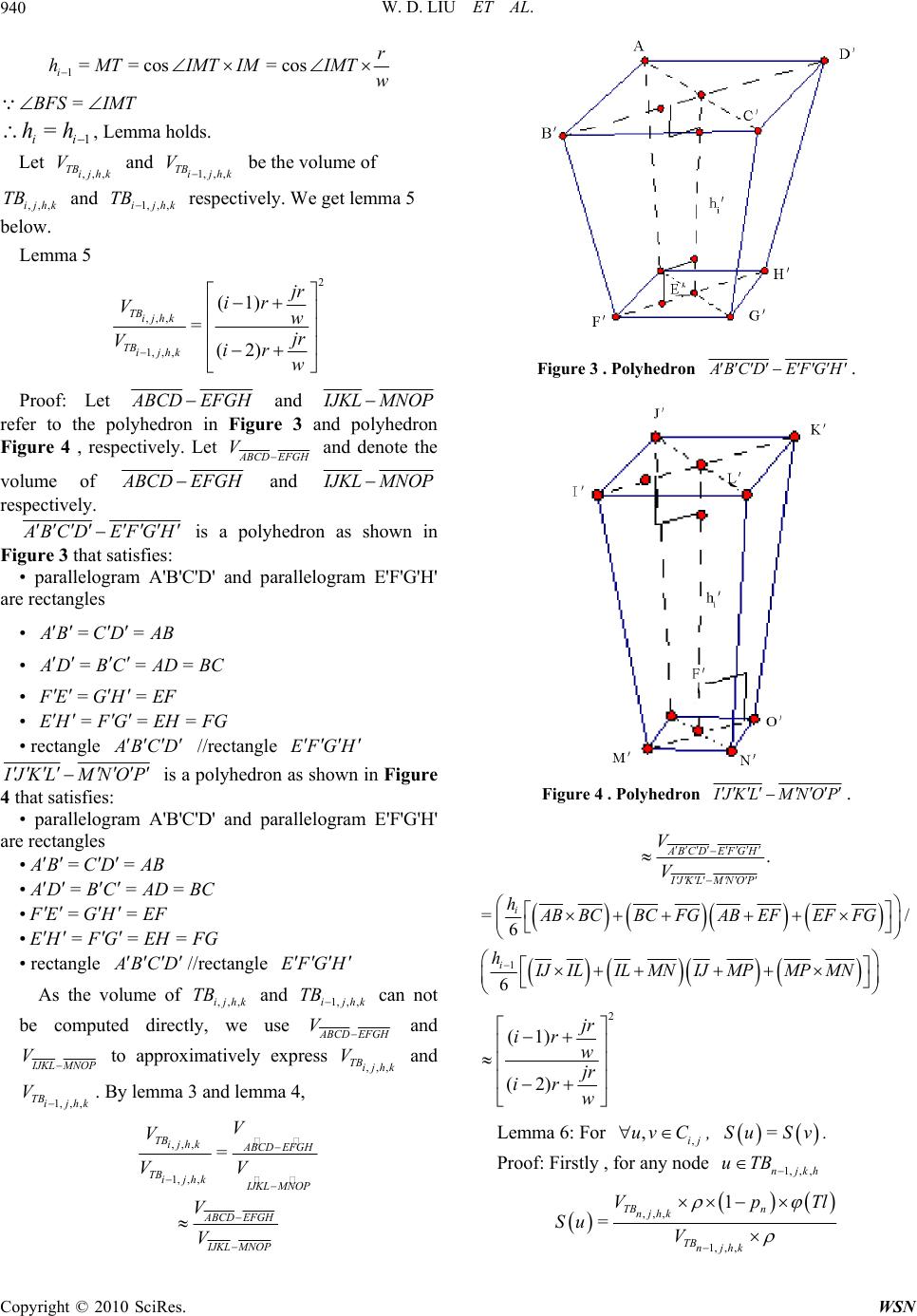 W. D. LIU ET AL. Copyright © 2010 SciRes. WSN 940 1== cos= cos ir hMTIMT IMIMTw =BFS IMT 1 = ii hh, Lemma holds. Let ,,, TBijhk V and 1,,, TBijhk V be the volume of ,,,ijhk TB and 1,, ,ijhk TB respectively. We get lemma 5 below. Lemma 5 2 ,,, 1,,, (1) = (2) TBijhk TBijhk jr ir Vw jr Vir w Proof: Let A BCD EFGH and I JKL MNOP refer to the polyhedron in Figure 3 and polyhedron Figure 4 , respectively. Let ABCD EFGH V and denote the volume of A BCD EFGH and I JKL MNOP respectively. A BCD EFGH is a polyhedron as shown in Figure 3 that satisfies: • parallelogram A'B'C'D' and parallelogram E'F'G'H' are rectangles • == A BCDAB • === A DBCADBC • == F EGHEF • ===EHFGEH FG • rectangle A BCD //rectangle EFGH I JKL MNOP is a polyhedron as shown in Figure 4 that satisfies: • parallelogram A'B'C'D' and parallelogram E'F'G'H' are rectangles •== A BCDAB •=== A DBCADBC •== F EGHEF •=== EHFGEH FG • rectangle A BCD //rectangle EFGH As the volume of ,,,ijhk TB and 1,, ,ijhk TB can not be computed directly, we use ABCD EFGH V and I JKL MNOP V to approximatively express ,,, TBijhk V and 1,,, TBijhk V. By lemma 3 and lemma 4, ,,, 1, , , = TBijhk ABCD EFGH TBijhk I JKL MNOP V V VV ABCD EFGH I JKL MNOP V V Figure 3 . Polyhedron A BCD EFGH . Figure 4 . Polyhedron IJKLMNOP . . ABCD EFGH IJKLMNOP V V 1 =/ 6 6 i i hAB BCBCFGABEFEFFG hIJILILMNIJMPMP MN 2 (1) (2) jr ir w jr ir w Lemma 6: For , ,ij uv C , =Su Sv. Proof: Firstly , for any node 1, ,,njkh uTB ,,, 1, , , 1 =TB n njhk TBnjhk VpTl Su V 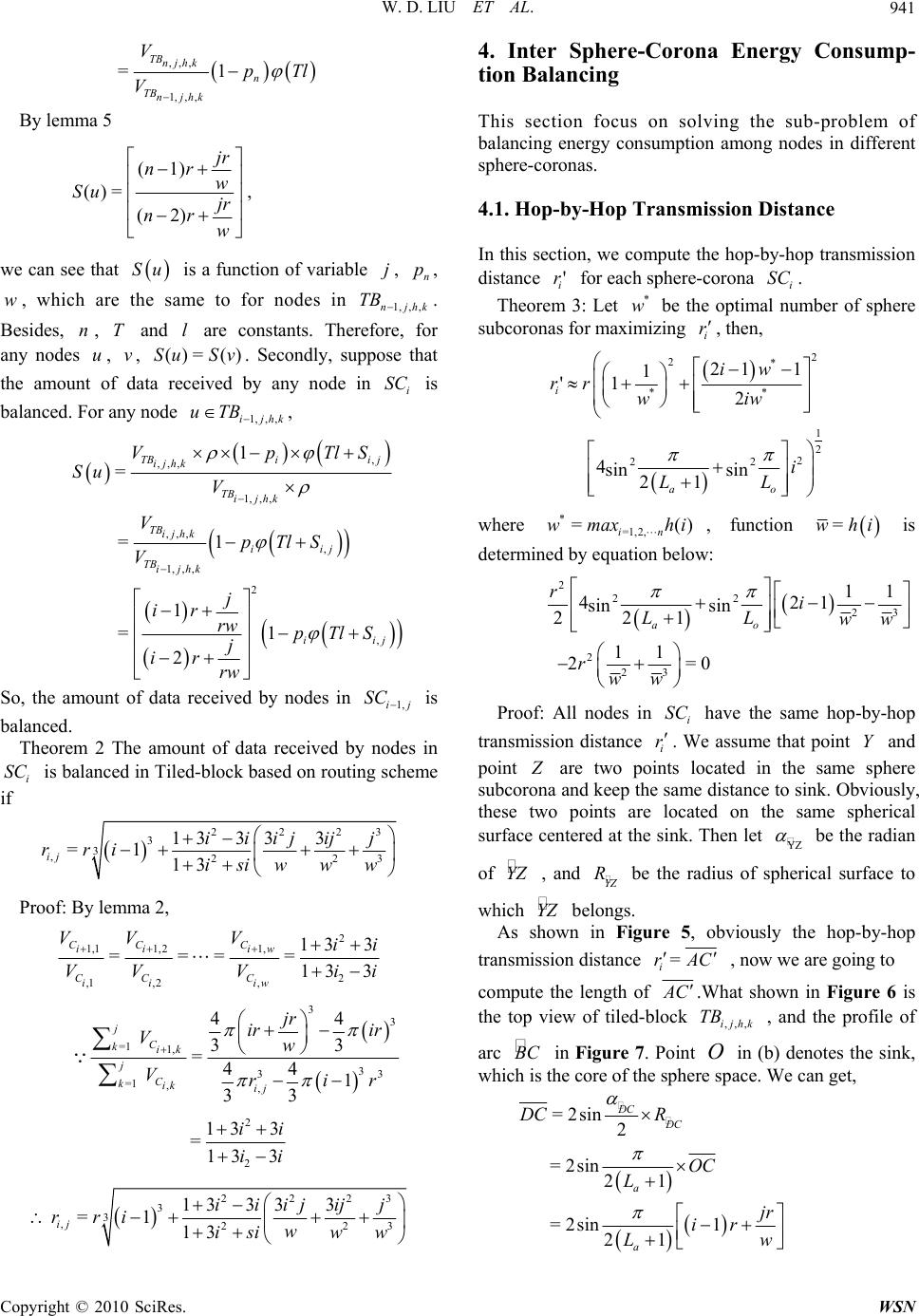 W. D. LIU ET AL. Copyright © 2010 SciRes. WSN 941 ,,, 1, , , =1 TBnjhk n TBnjhk VpTl V By lemma 5 (1) ()= (2) jr nr w Su jr nr w , we can see that Su is a function of variable j, n p, w, which are the same to for nodes in 1, , ,njhk TB . Besides, n, T and l are constants. Therefore, for any nodes u, v, ()= ()Su Sv. Secondly, suppose that the amount of data received by any node in i SC is balanced. For any node 1,,,ijhk uTB , , ,,, 1, , , 1 =TBii j ijhk TBijhk VpTlS Su V ,,, , 1, , , =1 TBijhk iij TBijhk VpTlS V 2 , 1 =1 2 iij j ir rw pTlS j ir rw So, the amount of data received by nodes in 1,ij SC is balanced. Theorem 2 The amount of data received by nodes in i SC is balanced in Tiled-block based on routing scheme if 2223 3 3 ,223 133 33 =1 13 ij iiijijj rri w isiw w Proof: By lemma 2, 2 1,1 1,21, 2 ,1 ,2, 13 3 ==== 13 3 CC C ii iw CC C ii iw VVV ii VVV ii 3 3 =1 1, 3 33 =1 ,, 44 33 =44 1 33 j C kik j C kik ij jr ir ir Vw Vrir 2 2 13 3 =133 ii ii 2223 3 3 ,223 133 33 =1 13 ij iiijij j rri w isiww 4. Inter Sphere-Corona Energy Consump- tion Balancing This section focus on solving the sub-problem of balancing energy consumption among nodes in different sphere-coronas. 4.1. Hop-by-Hop Transmission Distance In this section, we compute the hop-by-hop transmission distance ' i r for each sphere-corona i SC . Theorem 3: Let * w be the optimal number of sphere subcoronas for maximizing i r, then, 2 2* ** 21 1 1 '1 2 i iw rr wiw 1 2 2 22 4sin sin 21 ao i LL where * =1,2, =() in wmax hi , function =whi is determined by equation below: 2 22 23 11 421 sin sin 221 ao ri LL ww 2 23 11 2=0rww Proof: All nodes in i SC have the same hop-by-hop transmission distance i r . We assume that point Y and point Z are two points located in the same sphere subcorona and keep the same distance to sink. Obviously, these two points are located on the same spherical surface centered at the sink. Then let YZ be the radian of YZ , and YZ R be the radius of spherical surface to which YZ belongs. As shown in Figure 5, obviously the hop-by-hop transmission distance = i rAC , now we are going to compute the length of A C .What shown in Figure 6 is the top view of tiled-block ,,,ijhk TB , and the profile of arc BC in Figure 7. Point O in (b) denotes the sink, which is the core of the sphere space. We can get, =2sin2 DC D C DC R =2sin21 a OC L =2sin1 21 a jr ir Lw 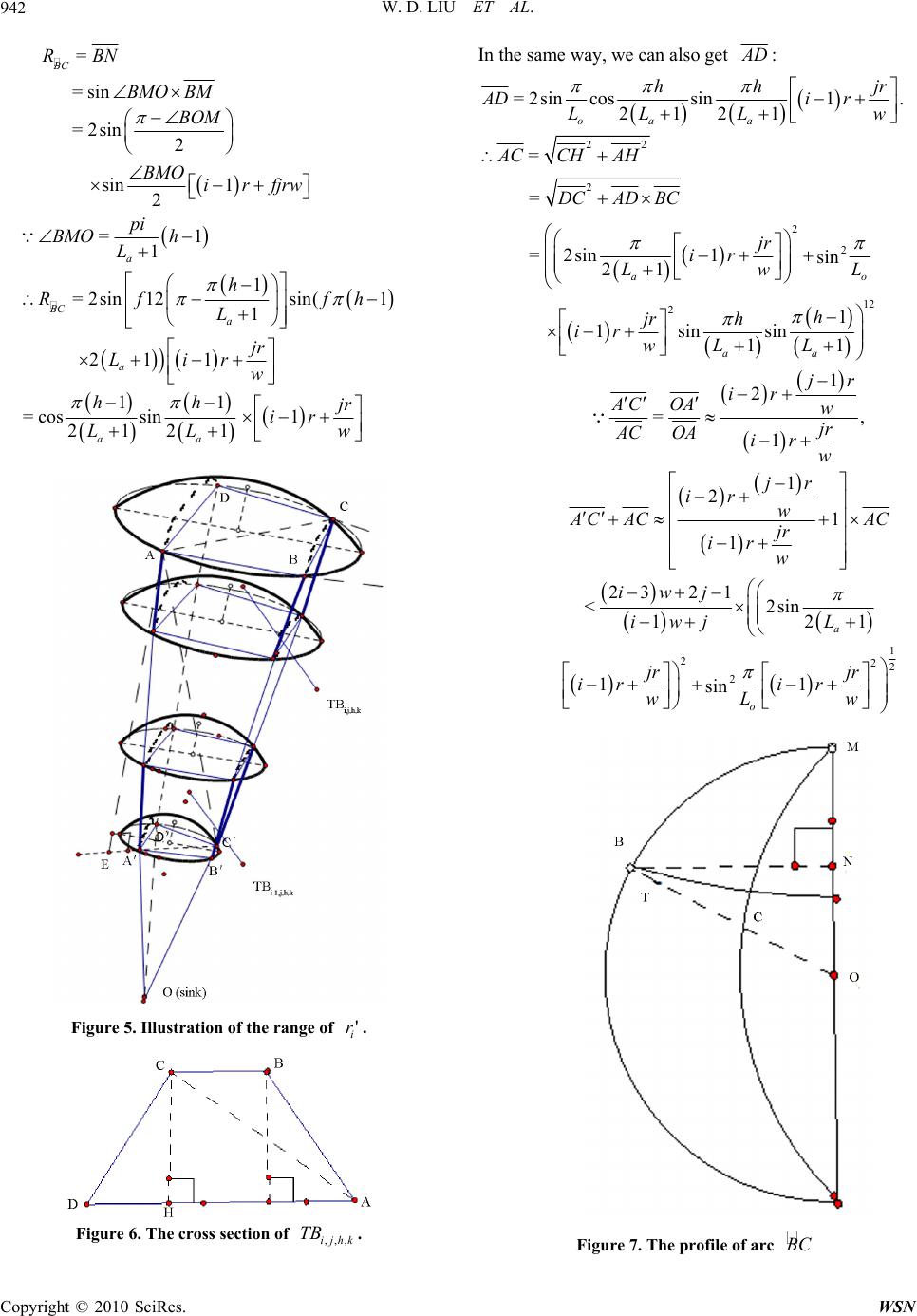 W. D. LIU ET AL. Copyright © 2010 SciRes. WSN 942 = BC RBN =sinBMO BM =2sin2 BOM sin 1 2 BMO irfjrw =1 1 a pi BMO h L 1 =2sin 12sin(1 1 BC a h Rf fh L 21 1 ajr Lir w 11 =cos sin 2121 aa hh LL 1jr ir w Figure 5. Illustration of the range of ' i r. Figure 6. The cross section of ,,,ijhk TB . In the same way, we can also get A D: =2sin cossin1. 2121 oa a hh jr ADi r LL Lw 22 = A CCHAH 2 =DCAD BC 2 2 =2sin1sin 21 ao jr ir LwL 12 21 1sin sin 11 aa h jr h ir wL L 1 2 =, 1 jr ir AC OAw jr AC OAir w 1 2 1 1 jr ir w A CAC AC jr ir w 232 1 <2sin 121 a iwj iwj L 1 222 2 11 sin o jr jr ir ir wL w Figure 7. The profile of arc BC 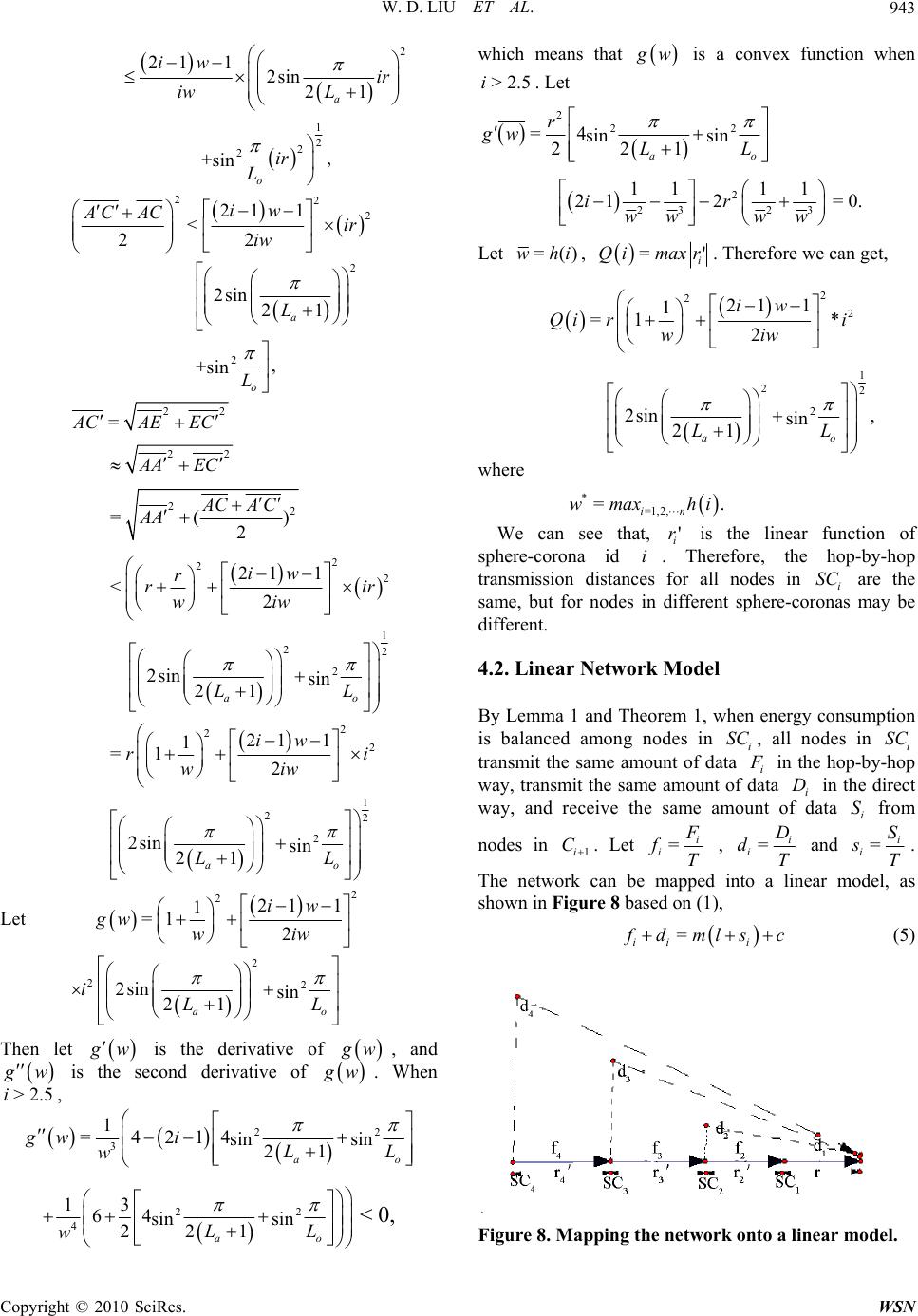 W. D. LIU ET AL. Copyright © 2010 SciRes. WSN 943 2 211 2sin 21 a iw ir iw L 1 2 2 2, sin o ir L 22 2 21 1 < 22 iw AC ACir iw 2 2sin 21 a L 2, sin o L 22 = A CAEEC 22 A AEC 22 =() 2 ACA C AA 2 2 2 21 1 <2 iw r rir wiw 1 22 2 2sin sin 21 ao LL 2 2 2 21 1 1 =1 2 iw ri wiw 1 22 2 2sin sin 21 ao LL Let 2 221 1 1 =1 2 iw gw wiw 2 22 2sin sin 21 ao iLL Then let g w is the derivative of g w, and g w is the second derivative of g w. When >2.5i, 22 3 1 =4214 sin sin 21 ao gwi LL w 22 4 13 64 sin sin 221 ao LL w 0,< which means that g w is a convex function when >2.5i. Let 2 22 =4 sin sin 221 ao r gw LL 2 23 23 11 11 21 2ir ww ww =0. Let =()whi, =' i Qimaxr. Therefore we can get, 2 2 2 21 1 1 =1 * 2 iw Qi ri wiw 1 22 2 2sin , sin 21 ao LL where * =1,2, =. in wmaxhi We can see that, ' i r is the linear function of sphere-corona id i. Therefore, the hop-by-hop transmission distances for all nodes in i SC are the same, but for nodes in different sphere-coronas may be different. 4.2. Linear Network Model By Lemma 1 and Theorem 1, when energy consumption is balanced among nodes in i SC , all nodes in i SC transmit the same amount of data i F in the hop-by-hop way, transmit the same amount of data i D in the direct way, and receive the same amount of data i S from nodes in 1i C . Let =i i F fT , =i i D dT and =i i S sT. The network can be mapped into a linear model, as shown in Figure 8 based on (1), = iii f dmlsc (5) Figure 8. Mapping the network onto a li n ear m odel . 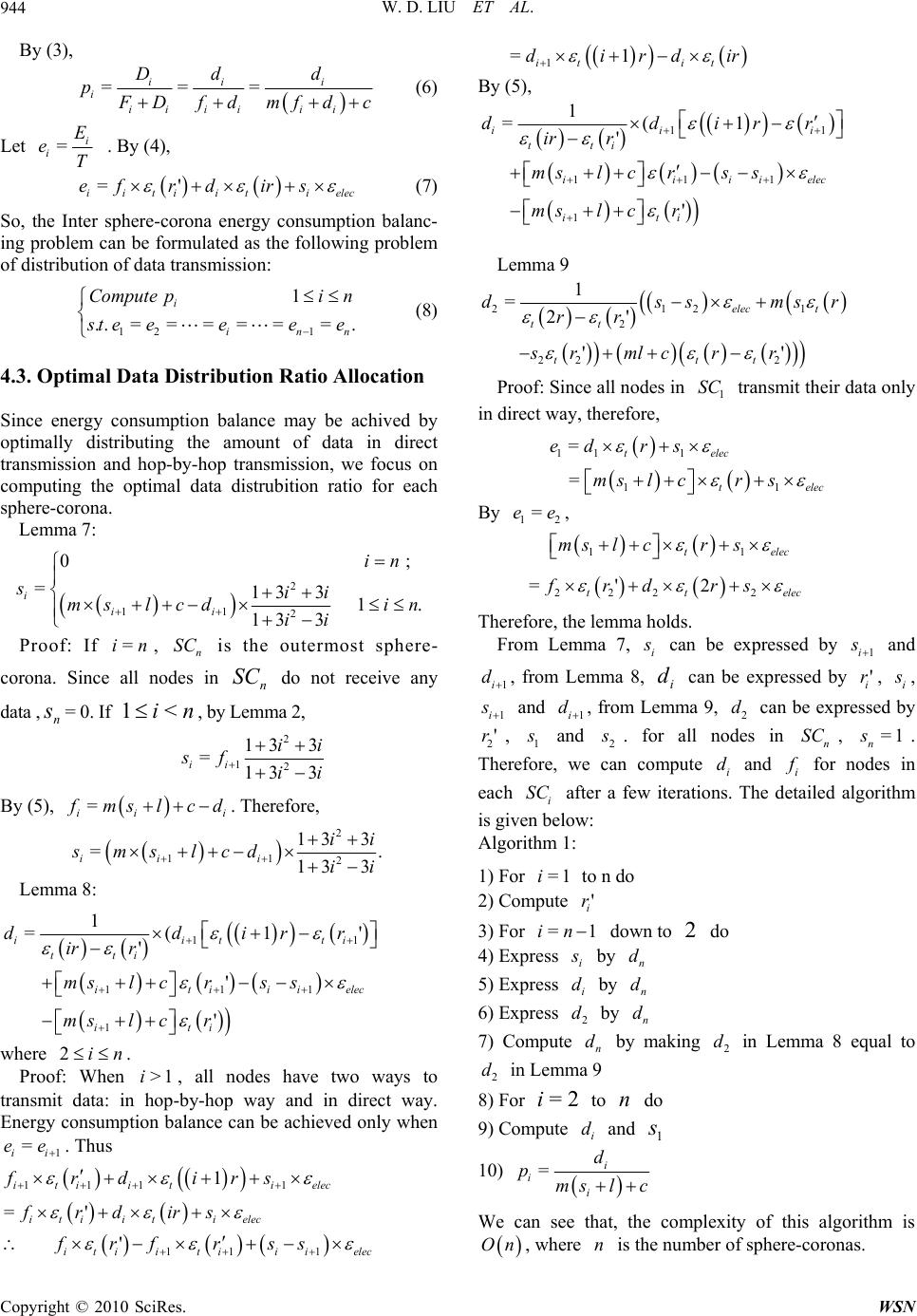 W. D. LIU ET AL. Copyright © 2010 SciRes. WSN 944 By (3), === ii i ii iiiii Dd d p F Dfdmfdc (6) Let =i i E eT . By (4), =' iiti itielec ef rd irs (7) So, the Inter sphere-corona energy consumption balanc- ing problem can be formulated as the following problem of distribution of data transmission: 121 1 ..= = ====. i inn Computepin s te eeee (8) 4.3. Optimal Data Distribution Ratio Allocation Since energy consumption balance may be achived by optimally distributing the amount of data in direct transmission and hop-by-hop transmission, we focus on computing the optimal data distrubition ratio for each sphere-corona. Lemma 7: 2 11 2 0 ; =13 3 1. 13 3 i ii in sii ms lcdin ii Proof: If =in, n SC is the outermost sphere- corona. Since all nodes in n SC do not receive any data ,n s= 0. If ni<1 , by Lemma 2, 2 12 13 3 =133 ii ii sf ii By (5), = ii i f mslcd. Therefore, 2 11 2 13 3 =. 13 3 ii i ii smslcd ii Lemma 8: 11 1 =(1' ' iitti tti ddirr ir r 111 ' itiiielec mslcrss 1' iti msl cr where 2in . Proof: When >1i, all nodes have two ways to transmit data: in hop-by-hop way and in direct way. Energy consumption balance can be achieved only when 1 = ii ee . Thus 111 1 1 i tiiti elec frd irs =' i tii ti elec frdirs 111 ' itiitiiielec frf rss 1 =1 it it dirdir By (5), 11 1 =(1 ' iii tti ddirr ir r 111iii ielec mslcrs s 1' iti msl cr Lemma 9 2121 2 1 =2' elec t tt dssmsr rr 22 2 '' ttt srmlc rr Proof: Since all nodes in 1 SC transmit their data only in direct way, therefore, 11 1 =telec edrs 11 =telec ms lcrs By 12 =ee, 11telec ms lcrs 222 2 =' 2 t t elec frd rs Therefore, the lemma holds. From Lemma 7, i s can be expressed by 1i s and 1i d , from Lemma 8, i d can be expressed by ' i r, i s , 1i s and 1i d , from Lemma 9, 2 d can be expressed by 2'r, 1 s and 2 s . for all nodes in n SC , =1 n s. Therefore, we can compute i d and i f for nodes in each i SC after a few iterations. The detailed algorithm is given below: Algorithm 1: 1) For =1i to n do 2) Compute ' i r 3) For =1in down to 2 do 4) Express i s by n d 5) Express i d by n d 6) Express 2 d by n d 7) Compute n d by making 2 d in Lemma 8 equal to 2 d in Lemma 9 8) For 2=i to n do 9) Compute i d and 1 s 10) =i ii d pmslc We can see that, the complexity of this algorithm is On, where n is the number of sphere-coronas.  W. D. LIU ET AL. Copyright © 2010 SciRes. WSN 945 4.4. Numerical Results and Analysis We have done numerical analysis , in order to understand how data compression ratio m influences the data transmission and reception. The system parameters are set as follows: = 100R,=10r,=10n,=50/ elec nJ bit , = 100/ amp pJ bit , and =2k. Figure 9 plots the amount of data received per node with different sphere-coronas. We can see that, sensors near the sink node receive more data from hop-by-hop transmission than those far from the sink node. Especially, nodes in the outmost sphere-corona (id = 10) receive no data as no one transmits data to them. This showns our scheme results in a desirable data distribution to achieve energy consumption balance. And we can also see that, as the data compression ratio m sets smaller, the amount of data received per node in the network becomes also smaller. This phenomenon manifests that data aggregation can reduce data transmitted and hence save energy consumption for WSNs. Figure 10 plots the ratios of data distribution in different sphere-coronas. The data distribution ratio firstly decreases rapidly, then remains constant more or less in the middle sphere-coronas and finally increases in the last few sphere-coronas. This can be explained as that, energy consumption is proportional to the production of data volume and square of the transmission distance. To maintain a balanced energy consumption, nodes at the two ends have a higher distribution ratio because at the near end nodes have heavy relay burden, but at the far end it just goes to the opposite: long transmitting distance but small data volume. And in Figure 10, it is also easily see that data compression ratio(m) has great influence on the distribution ratios. When m decreases, data distribution ratio also decreases at a rate following lemmas 5-7. Figure 9. Amount of data received per node for different sphere-coronas with different data aggregation ratios. Figure 10. The data distribution ratio different sphere- coronas with different data aggregation parameters. 5. Network Lifetime Maximization This section focused on solving the problem of maximizing network lifetime by achieving energy consumption balance among all nodes in the network. For nodes in the outmost sphere-corona n SC , =* nntnnt ef rdnr =k nelecampn mlcdr k nelecamp dR When energy consumption balance is achieved, all nodes have the same energy consumption equalength to n e. Thus, network lifetime maximization can be formulated as the following optimization problem: ; ..=, 1, =. n ij min e s teeijn nr R 5.1. Optimal Number of Sphere Subcoronas Given n sphere-coronas, i p and i d can be computed step by step using the algorithm above. By Theorem 3, the optimal number of sphere subcoronas w* can be obtained from: * =1,2, , =in wmaxhi Where function =whi is determined by equation below: 2 22 23 11 421 sin sin 221 ao ri LL ww 2 23 11 2=0rww  W. D. LIU ET AL. Copyright © 2010 SciRes. WSN 946 5.2. Optimal Number of Sphere-coronas By Lemma 8, i d is a nonlinear function of i r . Therefore, getting the optimal number of sphere-coronas is a nonlinear integer programming problem which is NP hard. We can use heuristic algorithm s to solve this problem. 6. The ECBDC Protocol In this section, a protocol called ECBDC (energy consumption balanced data collecting protocol) is designed. The operation of this protocol is divided into two phases: network set-up phase and data gathering phase. 6.1. Network Set-up Phase As discussed before, network parameters such as the optimal number of sphere-coronas n and the optimal data distribution ratio i p can be computed offline. Therefore, in the set-up phase, the sink broadcasts these parameters to all nodes and then each node establishes its sphere-corona id, source sphere subcorona id, destination sphere-corona id, tiled-block id and hop-by-hop trans- mission distance ' i r. Consider three consecutive sphere-coronas 1i SC , i SC and 1i SC . i SC acts as destination sphere-corona when the nodes in i SC receive data from nodes in 1i SC , and i SC acts as source sphere-corona when nodes in i SC forward data to nodes in1i SC . ,,,ijhk TB is the tiled block in which nodes located. For any node u, let ,, uuu be the three dimensional polar coordinates of node u. Since the network of monitoring sphere space S is divided into n sphere-coronas with equal width /Rn, we can get the sphere-corona ID i as follows: * == / uu rrn iRn R When node u in i SC forwards their data to the corresponding nodes in 1i SC , i SC acts the source sphere-corona. Since the source sphere-corona is divided into w sphere subcoronas with equal width //Rn w , the source sphere subcorona ID of node u can be given bellow: 1/ =/ u j ri Rn SRnw 1 =u nwr iRW R When node u in i SC receives data from the corresponding nodes in1i SC , i SC acts as the destination sphere-corona. By Theorem 2, the destination sphere-corona is divided into w sphere subcoronas with unequal width, so we can not simply get the destination sphere-corona ID like before. We give a simple algorithm based on Theorem 2 to compute the destination sphere-corona ID as follows: Algorithm 2: 1) For =1j to w do 2) If ,uij rr and ,1ij rr 3) Return j 4) End for As illustrated in Subsection 3.2, in Tiled-block based routing scheme, the spherical surface is divided with latitudes of number a L and then longitudes of number o L. Moreover, the o L longitudes divide spherical surface into Lo cambered surface with equal radian , and La latitudes divide each longitude into 1 a L equilength arcs. Nodes use two-tuples to express their Tiled-block ID (e.g ,hk). Tuple h locates nodes in the latitudinal direction and Tuple k locates nodes in the longitudinal direction. For any node u, ,, uuu denotes the three dimensional polar coordinates of u, Therefore, =2/ u o hL =2 uo L =/1 u a kL 1 =ua L 6.2. Data Gathering Stage As in [1], in ECBDC, all sensor nodes work between two states: active and sleep. In the former state, each node generates data, compresses data and transmits data. In the latter state, each node turns off its radio to save energy. Let round T be the time duration for completing one round of data gathering. round T is divided into nw* time slots 01*1 ,, , wn . In time slot i , nodes in , ii nwiw ww SC and 1, ii nwiw ww SC wake up, then nodes in , ii nwiw ww SC transmit data to nodes  W. D. LIU ET AL. Copyright © 2010 SciRes. WSN 947 in 1, ii nwiw ww SC , and in the meantime, other nodes in the sphere space get into sleep state. Let s Tu and d Tu be the timers to control node u enter into active state to transmit data and to receive data respectively. Let i l be the length of time slot i which is set as follows: , 3 =, 4/3 SC ii nwiw ww i V lR where , SC ii nwiw ww V is the space volume of , ii nwiw ww SC . The data gathering operation follows the DG algorithm proposed in [1], as shown in Appendix A. 7. Extension to Large-scale Data-gathering Sensor Networks In this section, we extend the ECBDC protocol to large-scale WSNs. In ECBDC, one of the preconditions is that the transmission range of each node is not less than the radius of the monitoring sphere space, so that every node can transmit data directly to the sink node when in direct mode. However, practically, most sensor nodes have a limited transmission range and may not transmit data to the sink node directly. Same as [1], we solve this problem with clustering technique [26-32]. We divide the whole network into small clusters. Each cluster is equiped with a special node called cluster head, which is located in the core of the cluster. All nodes in one cluster transmit data to its cluster head directly or hop by hop, then the head node transmit data to the sink node. The cluster head has battery energy which is much more than others. The data gathering in the extended ECBDC is implemented as follows: • Intra-Cluster: In each cluster, all nodes transmit their data to the cluster head using ECBDC. • Inter-Cluster: All the cluster heads form a super-clus- ter, and transmit data to the sink node using ECBDC. 8. Simulation Results and Analysis In this section, simulations have been made to evaluate the performance of ECBDC. As so far there is no known scheme for 3D WSNs, for comparison purpose, we choose two conventional 2D schemes: multihop routing scheme and direct transmitting scheme, and apply them to the 3D model. 8.1. Simulation Setup Sensor nodes are deployed in a sphere space, and the sink node is located in the core of the sphere. The radius of the sphere varys from 100 m to 1000 m and the data compression ratio varys from 0.1 to 1.0. All sensor nodes have the same initial energy 1J. In every round, each node generates 100 bits data. For the radio model, =50/ elec nJ bits , 2 =100 // amp pJbit m , and =2k. The value of all parameters are shown in Table 1 below. 8.2. Comparison with Direct Transmission and Multihop Routing Schemes In ECBDC, our target is to balance energy consumption and maximize network lifetime. In the best case, all nodes run out their energy in the same moment. In simulations, we pick up two conventional 2D schemes for comparison purpose: direct transmssion and multihop routing. In the direct method, all nodes in monitoring space transmit their data directly to sink node rather than getting through relay nodes; in the multihop method, every node forwards all its data to the next hop node. The ECBDC protocol and this two 2D schemes all run in the 3D model proposed in this paper. Figure 11 plots network lifetime achieved by the three schemes with different radius of the sphere space when the number of sphere-coronas 10nand data compression ratio 0.8m . We can see, with the growing R, network lifetime decreases dramatically. When R varys from 100 m to 600 m, ECBDC significantly outperforms other two schemes. And when R varys from 700 m to 1000 m, though still ECBDC outmatches the rivals, the differences among the three are not great. Figure 12 plots network lifetime obtained by the three schemes with different ratios of data compression when number of sphere-coronas 10n and sphere space radius 100 mR . Whenmvarys from 0.1 to 0.3, the multihop scheme is as good as ECBDC, which manifests that data compression is important, especially for multihop scheme and ECBDC. Effective data com- pression methods can bring low data compression ratio, reduce the amount of data transmitted, and hence lower energy consumption, prolonging network lifetime. In the figure, it’s worth noting that, whenmvary from Table 1. Value of all parameters. Parameter Value Network sphere radius(R) 100 1000mm Node deployment density( ) 0.1 3 /nodesm Initial energy 1/ J oulenode Data generation rate(l) 100 //bitsnoderound Data Compression ratio(m) 01 elec 50 /nJbit amp 100 3 // p Jbitm k 2 La 100 Lo 100 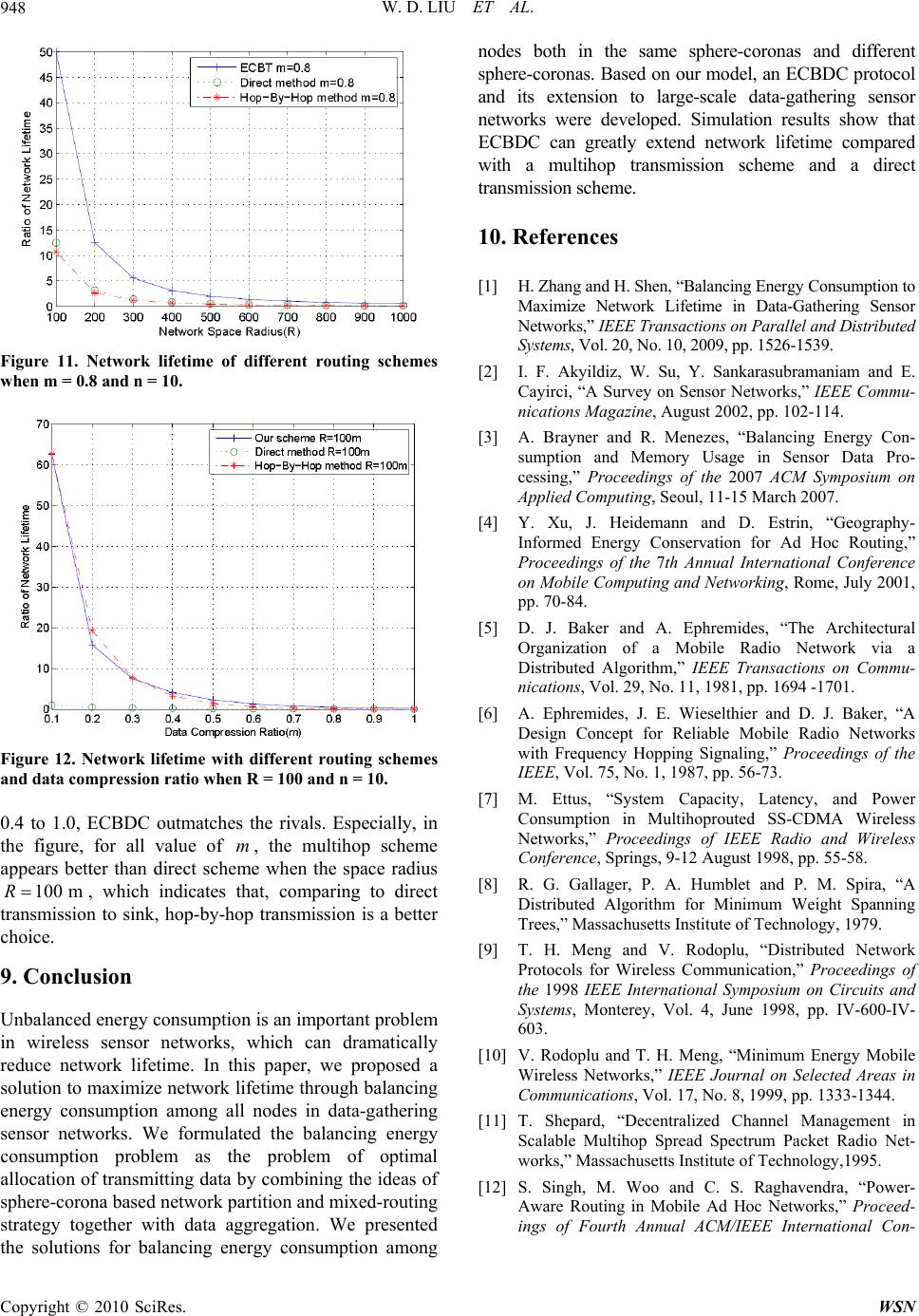 W. D. LIU ET AL. Copyright © 2010 SciRes. WSN 948 Figure 11. Network lifetime of different routing schemes when m = 0.8 and n = 10. Figure 12. Network lifetime with different routing schemes and data compression ratio when R = 100 and n = 10. 0.4 to 1.0, ECBDC outmatches the rivals. Especially, in the figure, for all value of m, the multihop scheme appears better than direct scheme when the space radius 100 mR, which indicates that, comparing to direct transmission to sink, hop-by-hop transmission is a better choice. 9. Conclusion Unbalanced energy consumption is an important problem in wireless sensor networks, which can dramatically reduce network lifetime. In this paper, we proposed a solution to maximize network lifetime through balancing energy consumption among all nodes in data-gathering sensor networks. We formulated the balancing energy consumption problem as the problem of optimal allocation of transmitting data by combining the ideas of sphere-corona based network partition and mixed-routing strategy together with data aggregation. We presented the solutions for balancing energy consumption among nodes both in the same sphere-coronas and different sphere-coronas. Based on our model, an ECBDC protocol and its extension to large-scale data-gathering sensor networks were developed. Simulation results show that ECBDC can greatly extend network lifetime compared with a multihop transmission scheme and a direct transmission scheme. 10. References [1] H. Zhang and H. Shen, “Balancing Energy Consumption to Maximize Network Lifetime in Data-Gathering Sensor Networks,” IEEE Transactions on Parallel and Distributed Systems, Vol. 20, No. 10, 2009, pp. 1526-1539. [2] I. F. Akyildiz, W. Su, Y. Sankarasubramaniam and E. Cayirci, “A Survey on Sensor Networks,” IEEE Commu- nications Magazine, August 2002, pp. 102-114. [3] A. Brayner and R. Menezes, “Balancing Energy Con- sumption and Memory Usage in Sensor Data Pro- cessing,” Proceedings of the 2007 ACM Symposium on Applied Computing, Seoul, 11-15 March 2007. [4] Y. Xu, J. Heidemann and D. Estrin, “Geography- Informed Energy Conservation for Ad Hoc Routing,” Proceedings of the 7th Annual International Conference on Mobile Computing and Networking, Rome, July 2001, pp. 70-84. [5] D. J. Baker and A. Ephremides, “The Architectural Organization of a Mobile Radio Network via a Distributed Algorithm,” IEEE Transactions on Commu- nications, Vol. 29, No. 11, 1981, pp. 1694 -1701. [6] A. Ephremides, J. E. Wieselthier and D. J. Baker, “A Design Concept for Reliable Mobile Radio Networks with Frequency Hopping Signaling,” Proceedings of the IEEE, Vol. 75, No. 1, 1987, pp. 56-73. [7] M. Ettus, “System Capacity, Latency, and Power Consumption in Multihoprouted SS-CDMA Wireless Networks,” Proceedings of IEEE Radio and Wireless Conference, Springs, 9-12 August 1998, pp. 55-58. [8] R. G. Gallager, P. A. Humblet and P. M. Spira, “A Distributed Algorithm for Minimum Weight Spanning Trees,” Massachusetts Institute of Technology, 1979. [9] T. H. Meng and V. Rodoplu, “Distributed Network Protocols for Wireless Communication,” Proceedings of the 1998 IEEE International Symposium on Circuits and Systems, Monterey, Vol. 4, June 1998, pp. IV-600-IV- 603. [10] V. Rodoplu and T. H. Meng, “Minimum Energy Mobile Wireless Networks,” IEEE Journal on Selected Areas in Communications, Vol. 17, No. 8, 1999, pp. 1333-1344. [11] T. Shepard, “Decentralized Channel Management in Scalable Multihop Spread Spectrum Packet Radio Net- works,” Massachusetts Institute of Technology,1995. [12] S. Singh, M. Woo and C. S. Raghavendra, “Power- Aware Routing in Mobile Ad Hoc Networks,” Proceed- ings of Fourth Annual ACM/IEEE International Con- 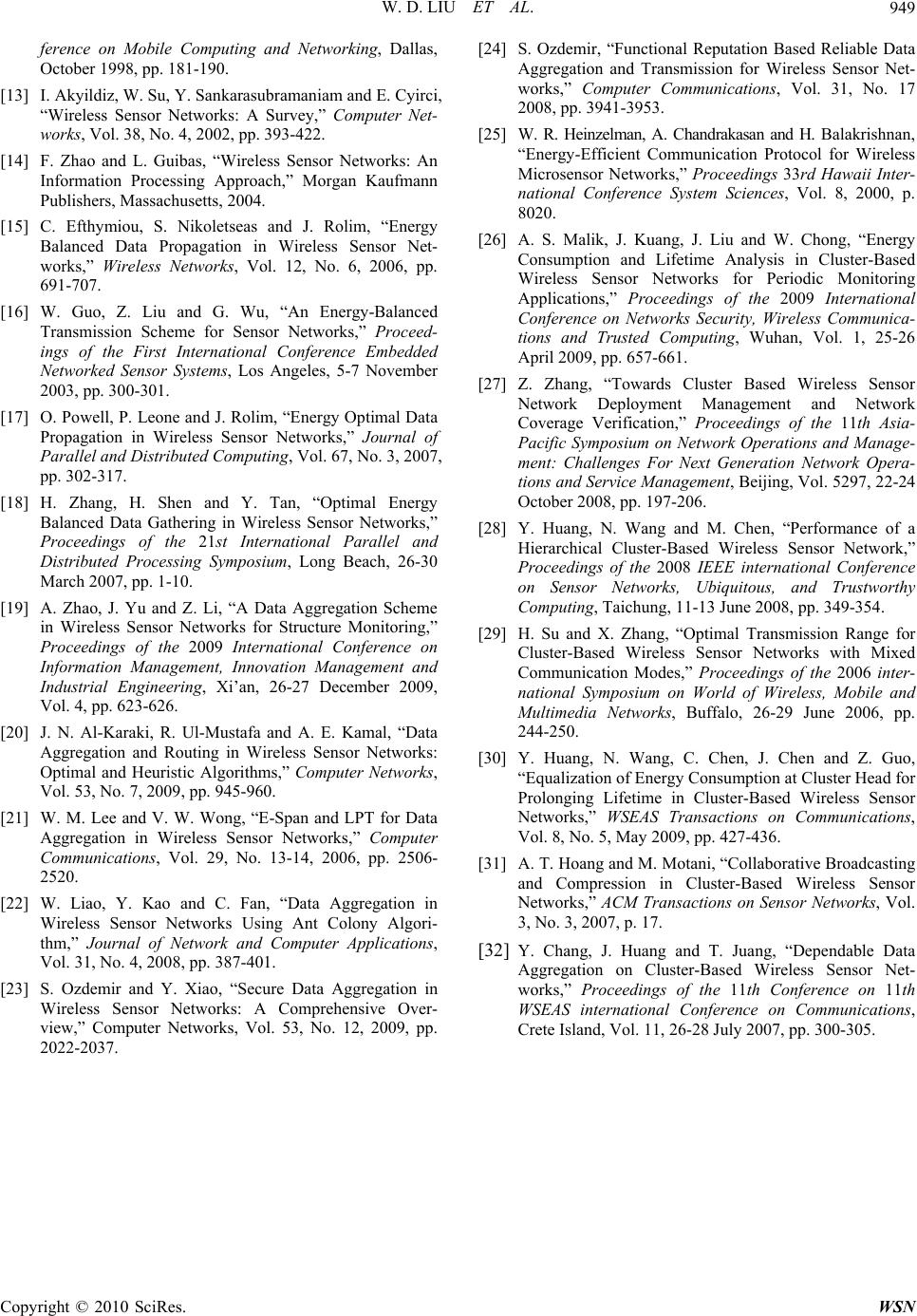 W. D. LIU ET AL. Copyright © 2010 SciRes. WSN 949 ference on Mobile Computing and Networking, Dallas, October 1998, pp. 181-190. [13] I. Akyildiz, W. Su, Y. Sankarasubramaniam and E. Cyirci, “Wireless Sensor Networks: A Survey,” Computer Net- works, Vol. 38, No. 4, 2002, pp. 393-422. [14] F. Zhao and L. Guibas, “Wireless Sensor Networks: An Information Processing Approach,” Morgan Kaufmann Publishers, Massachusetts, 2004. [15] C. Efthymiou, S. Nikoletseas and J. Rolim, “Energy Balanced Data Propagation in Wireless Sensor Net- works,” Wireless Networks, Vol. 12, No. 6, 2006, pp. 691-707. [16] W. Guo, Z. Liu and G. Wu, “An Energy-Balanced Transmission Scheme for Sensor Networks,” Proceed- ings of the First International Conference Embedded Networked Sensor Systems, Los Angeles, 5-7 November 2003, pp. 300-301. [17] O. Powell, P. Leone and J. Rolim, “Energy Optimal Data Propagation in Wireless Sensor Networks,” Journal of Parallel and Distributed Computing, Vol. 67, No. 3, 2007, pp. 302-317. [18] H. Zhang, H. Shen and Y. Tan, “Optimal Energy Balanced Data Gathering in Wireless Sensor Networks,” Proceedings of the 21st International Parallel and Distributed Processing Symposium, Long Beach, 26-30 March 2007, pp. 1-10. [19] A. Zhao, J. Yu and Z. Li, “A Data Aggregation Scheme in Wireless Sensor Networks for Structure Monitoring,” Proceedings of the 2009 International Conference on Information Management, Innovation Management and Industrial Engineering, Xi’an, 26-27 December 2009, Vol. 4, pp. 623-626. [20] J. N. Al-Karaki, R. Ul-Mustafa and A. E. Kamal, “Data Aggregation and Routing in Wireless Sensor Networks: Optimal and Heuristic Algorithms,” Computer Networks, Vol. 53, No. 7, 2009, pp. 945-960. [21] W. M. Lee and V. W. Wong, “E-Span and LPT for Data Aggregation in Wireless Sensor Networks,” Computer Communications, Vol. 29, No. 13-14, 2006, pp. 2506- 2520. [22] W. Liao, Y. Kao and C. Fan, “Data Aggregation in Wireless Sensor Networks Using Ant Colony Algori- thm,” Journal of Network and Computer Applications, Vol. 31, No. 4, 2008, pp. 387-401. [23] S. Ozdemir and Y. Xiao, “Secure Data Aggregation in Wireless Sensor Networks: A Comprehensive Over- view,” Computer Networks, Vol. 53, No. 12, 2009, pp. 2022-2037. [24] S. Ozdemir, “Functional Reputation Based Reliable Data Aggregation and Transmission for Wireless Sensor Net- works,” Computer Communications, Vol. 31, No. 17 2008, pp. 3941-3953. [25] W. R. Heinzelman, A. Chandrakasan and H. Balakrishnan, “Energy-Efficient Communication Protocol for Wireless Microsensor Networks,” Proceedings 33rd Hawaii Inter- national Conference System Sciences, Vol. 8, 2000, p. 8020. [26] A. S. Malik, J. Kuang, J. Liu and W. Chong, “Energy Consumption and Lifetime Analysis in Cluster-Based Wireless Sensor Networks for Periodic Monitoring Applications,” Proceedings of the 2009 International Conference on Networks Security, Wireless Communica- tions and Trusted Computing, Wuhan, Vol. 1, 25-26 April 2009, pp. 657-661. [27] Z. Zhang, “Towards Cluster Based Wireless Sensor Network Deployment Management and Network Coverage Verification,” Proceedings of the 11th Asia- Pacific Symposium on Network Operations and Manage- ment: Challenges For Next Generation Network Opera- tions and Service Management, Beijing, Vol. 5297, 22-24 October 2008, pp. 197-206. [28] Y. Huang, N. Wang and M. Chen, “Performance of a Hierarchical Cluster-Based Wireless Sensor Network,” Proceedings of the 2008 IEEE international Conference on Sensor Networks, Ubiquitous, and Trustworthy Computing, Taichung, 11-13 June 2008, pp. 349-354. [29] H. Su and X. Zhang, “Optimal Transmission Range for Cluster-Based Wireless Sensor Networks with Mixed Communication Modes,” Proceedings of the 2006 inter- national Symposium on World of Wireless, Mobile and Multimedia Networks, Buffalo, 26-29 June 2006, pp. 244-250. [30] Y. Huang, N. Wang, C. Chen, J. Chen and Z. Guo, “Equalization of Energy Consumption at Cluster Head for Prolonging Lifetime in Cluster-Based Wireless Sensor Networks,” WSEAS Transactions on Communications, Vol. 8, No. 5, May 2009, pp. 427-436. [31] A. T. Hoang and M. Motani, “Collaborative Broadcasting and Compression in Cluster-Based Wireless Sensor Networks,” ACM Transactions on Sensor Networks, Vol. 3, No. 3, 2007, p. 17. [32] Y. Chang, J. Huang and T. Juang, “Dependable Data Aggregation on Cluster-Based Wireless Sensor Net- works,” Proceedings of the 11th Conference on 11th WSEAS international Conference on Communications, Crete Island, Vol. 11, 26-28 July 2007, pp. 300-305. 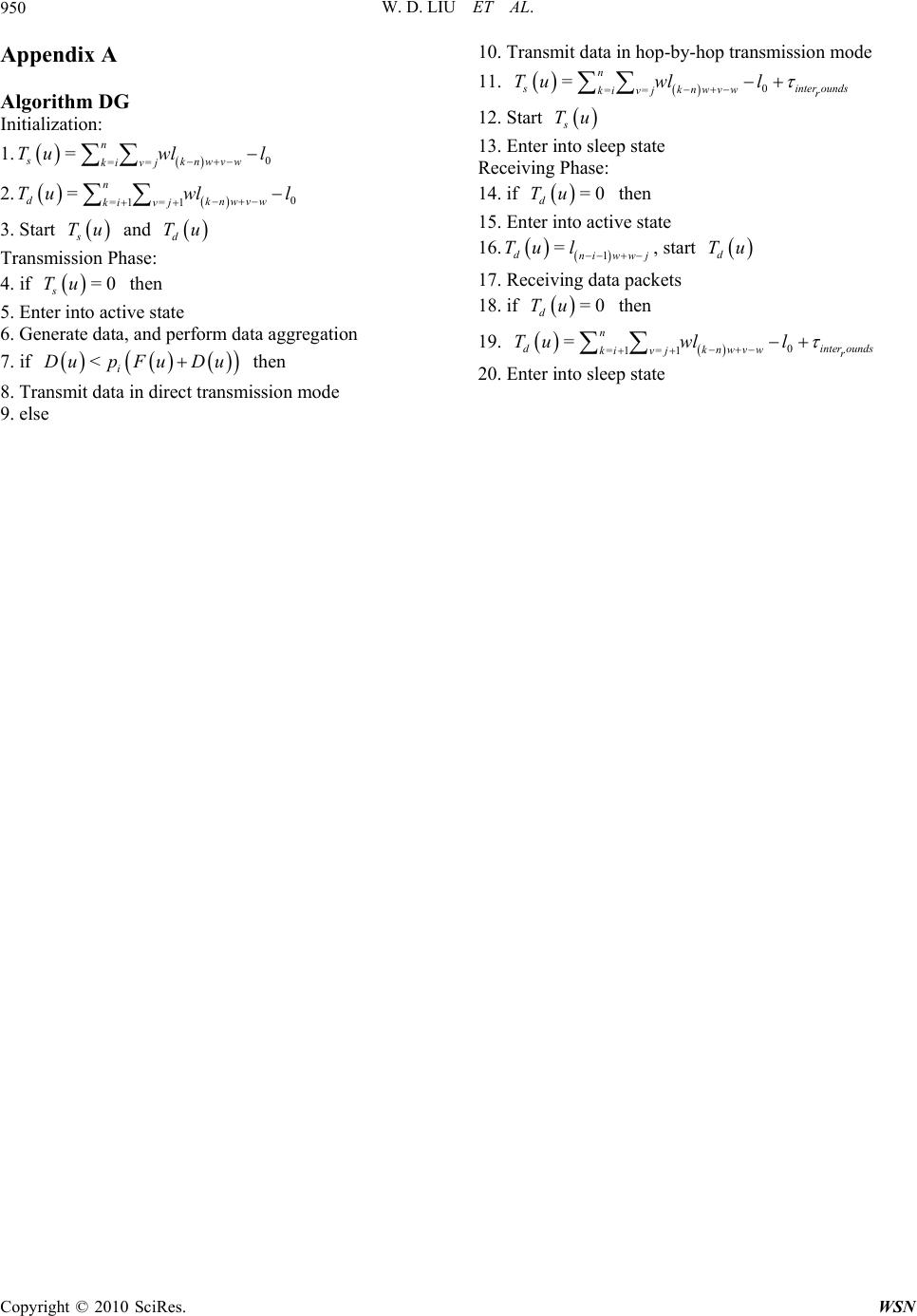 W. D. LIU ET AL. Copyright © 2010 SciRes. WSN 950 Appendix A Algorithm DG Initialization: 1. 0 == =n sknwvw ki vj Tuwll 2. 0 =1= 1 =n dknwvw ki vj Tuwl l 3. Start s Tu and d Tu Transmission Phase: 4. if =0 s Tu then 5. Enter into active state 6. Generate data, and perform data aggregation 7. if <i DupFuDu then 8. Transmit data in direct transmission mode 9. else 10. Transmit data in hop-by-hop transmission mode 11. 0 == =n s inter ounds knwvw ki vjr Tuwll 12. Start s Tu 13. Enter into sleep state Receiving Phase: 14. if =0 d Tu then 15. Enter into active state 16. 1 = dniww j Tu l , start d Tu 17. Receiving data packets 18. if =0 d Tu then 19. 0 =1= 1 =n dinter ounds knwvw ki vjr Tuwl l 20. Enter into sleep state |

